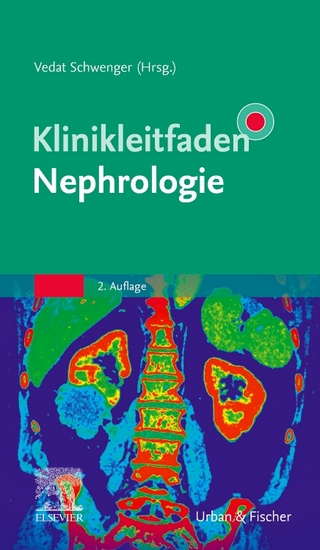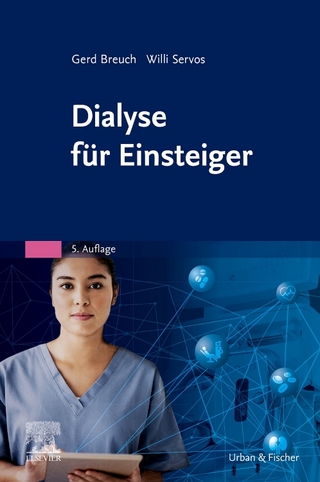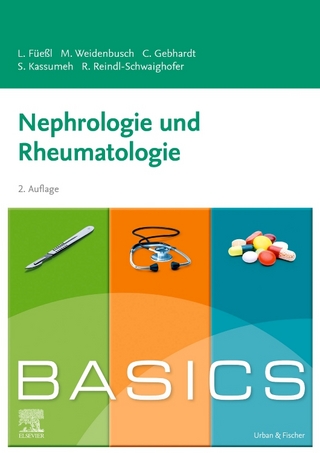
Current Therapy in Nephrology
Kluwer Academic Publishers (Verlag)
978-0-7923-0206-3 (ISBN)
- Titel ist leider vergriffen;
keine Neuauflage - Artikel merken
I. Glomerular Diseases.- Therapy of Nephritis: New Strategies.- Cell mediated immunity in glomerulonephritis: prospects for treatment.- Enzyme therapy of experimental glomerulonephritis.- DNA antibodies and idiotypes.- Reduction of protein excretion by allopurinol in rats with adriamycin nephrosis.- Clinical experience with an antithrombotic agent (defibrotide) in glomerular diseases. Preliminary results.- Defibrination with ancrod in crescentic glomerular lesions: preliminary observation.- PAF induced glomerular and vascular alterations in the isolated perfused rat kidney.- Histogenesis of glomerular crescents in idiopathic proliferative extracapillary glomerulonephritis. Clinical Aspects.- Premises for an antioxidant therapy in pregnancy induced nephropathy.- Pulse therapy with cyclophosphamide in primary and systemic glomerulopathy resistant to steroid treatment.- IgA Nephropathy.- Clinical presentation of IgA nephropathy in southern Italy.- Interleukin-2 production and abnormalities of immune regulation in patients with primary IgA nephropathy.- In vitro study of T lymphocyte activation in IgA nephropathy.- HLA class II histoglobulins involvement in mesangial IgA glomerulonephritis (Berger's disease).- Variation in T lymphocyte subsets in IgA nephropathy.- Acute renal failure as expression of IgA nephropathy.- Abnormal intestinal permeability in IgA nephropathy.- Nephrotic Syndrome.- Efficiency and tolerance of cyclosporine treatment in adult nephrosis.- Cyclosporine treatment of childhood idiopathic nephrosis.- Acute renal effects of intravenous high dose methylprednisolone therapy in nephrotic syndromes.- Should steroid therapy be used in nephrotic syndrome related to hepatitis B virus associated nephritis?.- Cyclosporine A therapy in nephrotic adults.- Cyclosporine effect on corticoresistant nephrotic syndrome in primary glomerulonephritis.- Effects of Cyclosporine A on renal function and proteinuria in patients with nephrotic syndrome after a single oral administration.- Cyclosporine A therapy in idiopathic nephrotic syndrome.- Captopril as an antiproteinuric agent in patients with chronic glomerulonephritis.- Steroid-resistant nephrotic syndrome treated with Cyclosporine A.- Miscellany.- Intravascular volume expansion as therapeutic approach to the underfill state of pre-eclampsia.- A prospective randomized therapeutic trial for schistosomal specific nephropathy.- Immunotactoid glomerulopathy: what about therapy?.- Renal presentation is not a relevant factor in predicting renal outcome in patients with systemic lupus.- Is tubulointerstitial damage a reliable index for predicting renal outcome in primary membranous nephropathy?.- Serum IgA in children with acute post-infectious glomerulonephritis.- Epidemiology of idiopathic glomerular disease in a french area: a prospective study.- II. Therapy in Renal Failure.- Plasma Exchange in Acute Renal Failure.- Clinical course of rapidly progressive glomerulonephritis during immunosuppressive therapy, plasma exchange and without specific therapy.- Plasma exchange in treatment of acute vascular rejection.- Evaluation of plasma exchange effect in patients with lung hemorrhage and rapidly progressive glomerulonephritis either idiopathic or vasculitis associated.- Current treatment of acute renal failure from leptospirosis.- Plasma exchange induced improvement on extra-renal manifestations of systemic lupus erithematosus.- Medical Therapy in Chronic Renal Failure.- Feasibility of an integrated diet-dialysis program as a treatment of ESRD.- Treatment of uremic anemia with etretinate: comparison with recombinant human erythropoietin.- Acute effects of carnitine addition to the dialysis fluid during hemodialysis in patients with chronic renal failure.- Clonidine is effective in the treatment of "restless legs" syndrome in chronic uremic patients.- Hemorheology and hypertension in end-stage renal failure patients treated with erythropoietin.- Effects of chronic hyperproteic diet on renal function and albumin excretion.- ACE inhibition and progression of renal injury in man.- One year experience with hypoproteic diet and once a week hemodialysis (less than 5 hours).- Calcitriol and renal failure.- Torasemide, a loop diuretic, useful in correcting ECF volume expansion in patients with chronic renal failure.- Miscellany.- Treatment of rapidly progressive lupus glomerulonephritis.- The effect of a single perinatal treatment with captopril on cytotoxicity in rats.- New evidence for the neurotoxicity of PTH in uremia.- Connection between chronic renal insufficiency and alluvial soils in central Greece.- III. Dialysis.- New Techniques.- Clearances of small solutes in hemodiafiltration and paired filtration dialysis.- L-carnitine addition in the dialysis fluid: a new therapeutical approach for hemodialysis patients.- Bidirectional bloodpump with a bidirectional bloodpassage through the artificial kidney.- Hemodialysis with low flow of sterile dialysate. Experience of two years.- Continuous veno-venous hemofiltration for hemodynamic stabilisation by blood cooling in septic shock.- Blood volume changes during hemodialysis detected by conductivity measurements.- A new hemodialysis single patient unit in the short dialysis treatments.- Paired filtration dialysis: better purification than conventional hemodialysis.- Modification of biohumoral and electromyographic features in patients on PFD: 12 months follow up results.- Restoration of the strength of ESRF patients by PFD.- Beta-2-Microglobulin.- Relation between red blood cell function and beta-2 microglobulin concentration in hemodialysis.- Beta-2-microglobulin adsorption on activated charcoal.- Clinical characteristics of beta-2-microglobulin associated amyloidosis in chronic haemodialysis patients.- Plasma beta-2-microglobulin changes induced by different dialysis membranes.- Intradialytic behaviour of beta-2-microglobulin during acetate dialysis, biofiltration and paired filtration dialysis.- In vitro influence of six dialysis membranes on beta-2-microglobulin behaviour.- Behaviour of beta-2-microglobulin in CRF patients starting blood purification.- Nutrition.- Standards for nutritional assessment in dialysis.- Is malnutrition a clinically evident condition in patients undergoing hemodialysis?.- Serum branch-chain amino- and ketoacids in the nutritional and immunological assessment of uremics on conservative and dialysis treatment.- Nutritional abnormalities as a guide to prognosis in hemodialyzed patients.- Relationship between physical activity and nutritional status in patients on maintenance hemodialysis.- Risk factors of malnutrition in RDT patients.- Dietetic supplements in malnourished patients undergoing chronic hemodialysis.- Biocompatibility.- Clinical aspects of hemodialysis biocompatibility.- Cellular aspects of biocompatibility.- Hemodialysis-associated neutrophil abnormalities and generation of leukotriene B4.- An immunohistochemical technique for the study of plasma proteins absorbed on dialysis membranes.- Adsorption of anaphylatoxins C3a and C5a on AN-69 and polysulfone membranes of dialyzer-In vivo study.- Blood cooling prevents degranulation of neutrophils during hemodialysis.- Long term effects of blood-material interactions.- Blood concentration of plasticizer at steady-state in dialysing patients: A model.- IgE ethylene antioxide and eosinophilia dialysis.- Criteria of Adequacy.- Criteria for adequate hemodialysis.- Dialytic adequacy of different replacement treatments.- Routine evaluation of kt/V and protein catabolic rate.- Adequacy of biofiltration: A comparative study with standard acetate hemodialysis.- Is it possible a mathematical verification of Kt/V?.- Adequacy of dialysis and prolonged reuse.- Acid-Base Balance.- Positive acid balance in patients undergoing chronic hemofiltration.- Trends of BUN and acid-base status during high efficiency hemodialysis.- Clinical results of acetate free biofiltration. Two years experience.- Successful treatment with bicarbonate dialysis of severe lactic acidosis in phenformin treated patients on dialytic treatment.- Metabolic assessment of acetate-free biofiltration.- Bicarbonate and calcium balance in postdilutional hemodiafiltration.- Vascular Access.- Intra-arterial digital subtraction angiography for evaluation of AV-fistulas in hemodialysis patients.- Miscellany.- Oxalate clearance by high-flux haemodialysis using polyacrylonitrile membranes.- Technical and clinical evaluation of a new low flux polysulphon membrane.- Ultrafiltration control in short time dialysis.- Red cell fragmentation syndrome in chronic single needle dialysis.- Hypotension and cardiac arrhythmias: A consequence of left ventricular hypertrophy in dialysis.- One-year experience with short dialysis using a high efficiency dialyzer.- The influence of nifedipine on serum lipids in elderly chronic dialysis patients.- Effect of dialysate calcium concentration changes on plasma calcium and PTH in dialysis patients treated with calcium carbonate as a phosphate binder.- Cerebral atrophy in long-term haemodialyzed patients.- Beneficial effect of desferrioxamine on the anaemia of a haemodialysis patient without aluminium or iron overload.- Transient erythrocyte volume increase in hemodialysis.- Assessment of liver ability to biotransformation of antipyrine in uraemic patients on regular peritoneal dialysis treatment.- Clinical pitfalls of short-term dialysis.- Pharmacokinetics of chlordesmethyldiazepam in patients on regular hemodialysis.- Effect of polyacrylonitrile membrane upon plasma osteocalcin and iPTH levels in patients on maintenance hemodialysis.- Abdominal hernias as complication of C.A.P.D.: Importance of the early diagnosis and surgery.- Hemodialysis in the elderly.- IV. Transplantation.- Age and Renal Transplantation.- Age and renal transplantation.- Influence of recipient age on the outcome of cadaver kidney transplantation in patients treated with cyclosporine.- Renal replacement therapy in patients over 60 years of age and the use of elderly living donors.- Impact of donor age in relation with graft survival and quality of remaining kidney of donor.- Is age over 55 years risk factor for kidney donor and for graft function in living related renal transplantation?.- Renal transplantation in patients aged over 50 years.- Kidney transplantation at an advanced age.- Cadaveric renal tranplantation in the elderly.- Renal transplantation in elderly recipients.- Renal transplantation with elderly donor.- Miscellany.- Calcium antagonists prevent lymphocyte activation in kidney allograft recipients.- A prospective randomized study of the protective effect of verapamil on the ischaemic renal injury in renal allotransplants.- Effects of systemic administration of the PGE-1 analogue alprostadil in the early phase of renal transplantation.- Interleukin-2 production by peripheral blood lymphocytes in the diagnosis of renal allograft rejection in cyclosporin treated patients.- Changes of anti-thrombin III, protein C, and protein S in renal transplantation.- Kaposi's sarcoma after kidney transplantation, an etiologic study and successful treatment.- Renal arterial stenosis in renal transplantation: A mathematical pathogenetic hypothesis and its possible clinical implications.- "Renal functional reserve" in renal transplant patients on cyclosporine therapy.- V. Cyclosporine.- Drug Interactions.- Sandimmun(r) /An appraisal of drug interactions.- Drug interaction between cyclosporin A and macrolides antibiotics: Study in vitro and in vivo.- Interaction of calcium antagonists and cyclosporine A.- Cyclosporine and H2 receptor antagonists drug interaction in the Sprague-Dawley rat.- Cyclosporine A drug interactions.- Cyclosporine A and glybenclamide. Effect on glucose metabolism: Preliminary results.- Side Effects.- Acute cyclosporine A nephrotoxicity.- Renal pathology after low dose cyclosporine in patients with primary Sjogren's syndrome.- The influence of cyclosporine on cytomegalovirus-related kidney graft survival.- Kaposi's sarcoma in kidney graft recipients treated with low doses of cyclosporine.- A cellular mechanism for cyclosporine A-induced nephrotoxicity.- Dopamine reverses acute cyclosporine A nephrotoxicity. Micropuncture study in the rat.- Reversibility of acute cyclosporine renal impairment by dopamine in healthy subjects.- Relation between gengival overgrowth and cyclosporine blood levels in renal transplanted patients.- Author Index.
| Erscheint lt. Verlag | 30.4.1989 |
|---|---|
| Reihe/Serie | Developments in Nephrology ; 24 |
| Zusatzinfo | biography |
| Sprache | englisch |
| Gewicht | 1150 g |
| Themenwelt | Medizinische Fachgebiete ► Innere Medizin ► Nephrologie |
| ISBN-10 | 0-7923-0206-0 / 0792302060 |
| ISBN-13 | 978-0-7923-0206-3 / 9780792302063 |
| Zustand | Neuware |
| Haben Sie eine Frage zum Produkt? |
aus dem Bereich


